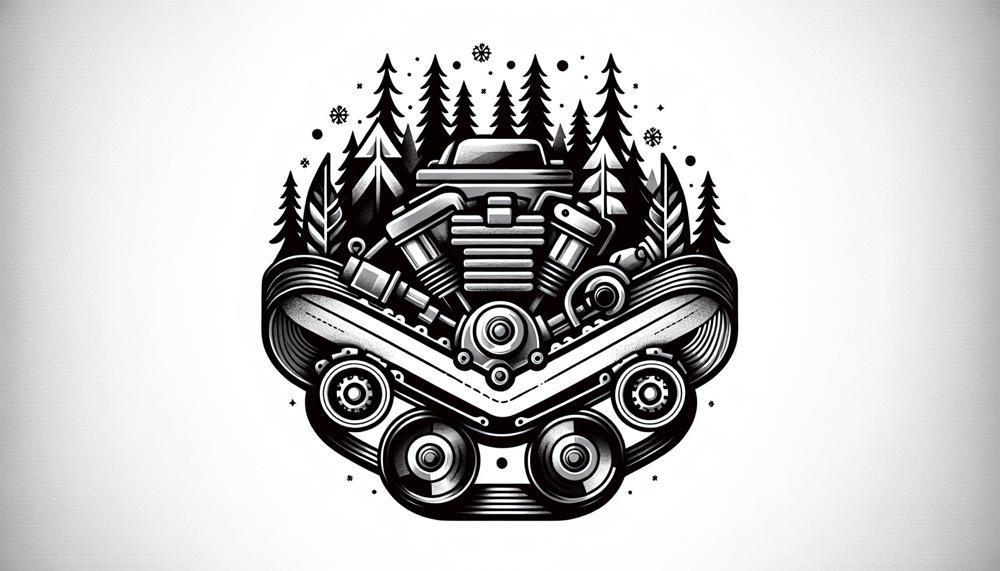Imagine this: You’re gliding through a winter wonderland, the brisk breeze caressing your cheeks as you navigate your trusty snowmobile. But suddenly, there’s a jarring screech and your ride grinds to a halt. What could have caused this unexpected interruption? Chances are, it’s time to bid farewell to your snowmobile belt.
So, how long do snowmobile belts last?
Snowmobile drive belts typically last between 1,500–2,000 miles. However, factors like heat, cold, stretching, and spinning can affect the belt’s performance and lifespan. Belts can also start to degrade after seven years, even if they are stored properly.
In this blog post, we’ll delve into the world of snowmobile belts – discussing their significance, average lifespan, warning signs of wear and tear, and tips for extending their longevity.
So fasten your seatbelts and get ready to discover everything you need to know about the journey of a snowmobile belt from beginning to end.
What is a Snowmobile Belt?
Contents
- 1 What is a Snowmobile Belt?
- 2 How Long Does a Snowmobile Belt Last?
- 3 What Causes a Snowmobile Belt to Break?
- 4 Why Does Your Snowmobile Belt Squeal?
- 5 How do You Adjust the Tension on a Snowmobile Belt?
- 6 When Should You Replace Your Snowmobile Belt?
- 7 How Much Does a Snowmobile Belt Cost?
- 8 How do You Clean a Snowmobile Belt?
- 9 How do You Change a Snowmobile Belt?
- 10 Conclusion
A snowmobile belt serves an essential purpose of transferring power from the engine to the track, allowing the snowmobile to efficiently move. This is achieved through the use of rubber compounds and cords reinforced with strong materials such as Kevlar. The shape and size of the belt are also crucial in maintaining proper tension and fit in the drive system.
The role of a snowmobile belt is vital in ensuring the overall performance and longevity of a snowmobile. A well-functioning belt guarantees that power is transferred smoothly, resulting in optimal performance. However, a worn-out or damaged belt can significantly impact the snowmobile’s performance, leading to issues like power loss, slipping, or even breakdowns.
Regularly inspecting and replacing the snowmobile belt when necessary is crucial for maintaining its performance and avoiding costly repairs. Neglecting the belt can quickly result in it breaking down, making proper maintenance essential.
Factors like riding conditions, terrain, and maintenance habits also play a role in determining the lifespan of a snowmobile belt. On average, a snowmobile belt can last between 2,000 to 4,000 miles, but this may vary depending on individual riding habits.
How Long Does a Snowmobile Belt Last?
The longevity of a snowmobile belt can be influenced by multiple factors, such as the quality of the belt itself, riding conditions, sled performance, and clutch settings.
Proper maintenance and care also play a significant role in extending the life of a snowmobile belt. Consider these factors below:
- Belt Quality: The quality of the snowmobile belt can greatly impact its lifespan. High-quality belts, crafted with durable materials, tend to have a longer lifespan compared to lower quality ones.
- Riding Conditions: The type of terrain and riding style can also affect how long a snowmobile belt lasts. Rough or off-trail riding can put more strain on the belt, causing it to wear out faster.
- Sled Performance: Sleds with high-performance engines may put more stress on the belt, leading to a shorter lifespan. It is essential to choose a belt that can withstand your sled’s power output.
- Clutch Settings: Proper clutch settings are crucial for optimal performance and extending the life of a snowmobile belt. Adjusting the clutch according to your riding conditions and sled’s power output is vital.
To ensure that your snowmobile belt lasts as long as possible, here are some tips:
- Regular Maintenance: Proper maintenance is key to prolonging the life of a snowmobile belt. Keep an eye on wear and tear, regularly clean any debris or buildup, and make necessary adjustments.
- Break-in Period: When installing a new belt, properly breaking it in before riding at full throttle is essential. This helps the belt adjust to your sled’s specific clutch settings and extends its lifespan.
- Warm-up: Warming up your sled before riding can also help prevent unnecessary strain on the belt, especially during cold weather.
- Storage: Store your sled in a dry and cool place during off-seasons and make sure that the belt is stored properly as well. Moisture and extreme temperatures can cause damage to the belt.
What Causes a Snowmobile Belt to Break?
It’s crucial to comprehend the reasons behind snowmobile belt breakage because it can aid in avoiding expensive repairs and replacements, as well as ensuring the safety and efficiency of the machine.
By understanding what factors can lead to belt breakage, snowmobilers can take preventive measures and properly maintain their belts, ultimately prolonging their lifespan. This not only saves money in the long term but also guarantees a more seamless and safer riding experience.
Snowmobiles are complex machines, and a lot can go wrong when riding them. However, one of the most frustrating issues is a broken belt. This often happens at the most inconvenient time, leaving you stranded far from home or your destination.
But what causes a snowmobile belt to break? There are several factors that contribute to this problem, and understanding them is key to preventing such an issue from occurring.
Firstly, the weight of the rider can play a significant role. Snowmobiles are designed to accommodate a certain amount of weight, and exceeding that limit can put undue pressure on the belt, causing it to snap. Additionally, riding conditions also play a part. For instance, if you’re riding on rough terrain or through deep snow, the belt is likely to experience more strain and wear out faster.
Another common cause of belt breakage is lack of maintenance. Just like any vehicle, snowmobiles require regular upkeep to function at their best. This includes inspecting and replacing worn-out parts, such as the belt. Failure to do so can result in a broken belt while out on a ride.
To avoid these issues, it’s essential to properly maintain your snowmobile and be mindful of weight limits while riding.
Additionally, investing in high-quality belts and regularly inspecting them for wear and tear can also prevent unexpected breakdowns.
Why Does Your Snowmobile Belt Squeal?
Snowmobiling is a popular winter activity, but it can quickly turn into a noisy and unpleasant experience if your snowmobile belt starts squealing. There are several factors that can contribute to this issue, including excessive heat, improper tension, and wear and tear.
To prevent snowmobile belt squealing, it’s essential to regularly inspect and maintain your snowmobile and follow proper riding practices.
Excessive Heat:
One of the most common reasons for snowmobile belt squealing is excessive heat. The high temperatures generated during operation can cause the belt material to wear and slip, resulting in a squealing sound.
To avoid this issue, make sure your snowmobile’s cooling system is in good condition and avoid riding in conditions that can cause the engine to overheat.
Improper Tension:
Another factor that can lead to snowmobile belt squealing is improper tension. If the belt is too loose, it can slip and produce a squealing noise. On the other hand, if the belt is too tight, it can cause excessive wear on the belt and other components.
To prevent this, regularly check and adjust the belt tension according to the manufacturer’s recommendations.
Worn or Damaged Belts:
Worn or damaged belts can also contribute to poor clutch engagement and produce a squealing sound.
That’s why it’s crucial to inspect your belt regularly for signs of wear or damage and replace it when necessary.
Proper Maintenance:
Regular maintenance and inspections are key in preventing snowmobile belt squealing. This includes checking for wear and tear on the belt, adjusting tension, and ensuring all other components are in good condition.
By following proper maintenance practices, you can prolong the lifespan of your snowmobile belt and enjoy a quieter, smoother, and safer ride.
In Conclusion:
Snowmobile belt squealing can be prevented by understanding its common causes, conducting regular maintenance and inspections, and adhering to proper riding practices.
By taking these preventive measures, you can enjoy a quieter and safer snowmobiling experience while also extending the lifespan of your snowmobile belt.
How do You Adjust the Tension on a Snowmobile Belt?
Keeping the proper tension on your snowmobile belt is crucial for its longevity and performance. A well-adjusted belt prevents overheating and excessive wear from aggressive riding, allowing it to transfer power efficiently without slipping or overheating.
However, both loose and overly tight tension can have negative effects on the lifespan of your belt.
| Adjustment Type | Effect on Belt Lifespan | Reason |
| Proper Tension | Increases lifespan | Prevents overheating and excessive wear |
| Loose Tension | Decreases lifespan | Causes overheating and premature wear |
| Overly Tight Tension | Decreases lifespan | Stresses bearings and shafts, leading to failure |
Adjusting the tension on a snowmobile belt is a simple process that can be done with basic tools. Follow these steps to adjust the tension properly:
- Warm up the engine: Before adjusting the tension, let the engine warm up for a few minutes to allow the belt to expand.
- Find the tensioner: The tensioner is typically located near the secondary clutch and has a bolt in the center that can be loosened or tightened.
- Loosen the bolt: Use a wrench or socket to loosen the bolt in the center of the tensioner.
- Adjust the tension: With the bolt loosened, turn the adjuster nut clockwise to tighten or counterclockwise to loosen the belt.
- Check the tension: The belt should be tight enough to prevent slipping but not so tight that it causes difficulty starting at idle RPM. You can also test the tension by pressing down on the belt with your finger, it should have slight give but not be too loose.
- Tighten the bolt: Once you have adjusted the tension, tighten the bolt in the center of the tensioner.
- Test ride: Take your snowmobile for a short ride to ensure that the belt is properly adjusted and there is no squealing or slipping.
Regularly checking and adjusting the tension on your snowmobile belt can greatly improve its lifespan and prevent costly repairs or replacements. It is recommended to check the tension before every ride and make adjustments as needed.
Additionally, following proper riding practices such as avoiding excessive heat and break-in periods for new belts can also contribute to a longer lifespan.
When Should You Replace Your Snowmobile Belt?
Failure to do so may result in unexpected breakdowns, poor performance, and potential safety hazards. To help you determine when it’s time to replace your snowmobile belt, here are some key indicators to look out for:
- Visual Inspection: Before every ride, take a moment to visually inspect your snowmobile belt. Look for any visible cracks, uneven wear, flat spots, or fraying. If any of these signs are present, it is time to replace your belt.
- Mileage: On average, snowmobile belts should be replaced every 1000-1500 miles. It is essential to keep track of your mileage and plan ahead for a belt replacement.
- Tension Adjustment: Proper tension adjustment is crucial for the longevity of your snowmobile belt. If you have recently adjusted the tension and are still experiencing issues with power transfer or overheating, it may be time to replace your belt.
- Physical Damage: Regularly inspect your belt for any fraying, hour-glassing, loose cords, missing cogs, abrasions, burns, or other physical damage. Any of these signs indicate that a belt change is necessary.
- Performance Issues: A worn-out belt can significantly impact the performance and efficiency of your snowmobile. If you notice a decrease in power or fuel efficiency while riding, it may be time to replace your belt.
- Clutch Settings: If you have recently made changes to your clutch settings and are still experiencing issues with power transfer or overheating, it could be a sign that your snowmobile belt needs replacing.
How Much Does a Snowmobile Belt Cost?
The price of a snowmobile belt can vary greatly, typically ranging from $50 to $150. Various factors may impact the cost, including the material used, your riding style, the brand of the belt, and the age and condition of your snowmobile. Although it may require a higher upfront investment, opting for a top-quality and sturdy belt can ultimately save you money in the long term.
When it comes to purchasing a snowmobile belt, there are several key factors to consider that can greatly affect the overall cost. One such factor is the type of material used in the construction of the belt. Higher quality materials such as Kevlar or carbon fiber may come at a higher price point compared to cheaper materials like rubber.
Another important consideration is your riding style. If you are an aggressive rider who frequently takes on rough terrain and makes sharp turns, you may need a stronger and more durable belt, which can also come with a higher price tag.
The brand of the belt can also play a significant role in its cost. More reputable and well-known brands often come with a higher price due to their reputation for producing high-quality products. However, this higher cost may be worth it in terms of longevity and performance.
It’s also essential to take into account the age and condition of your snowmobile when determining the cost of a new belt. An older or poorly maintained snowmobile may require more frequent belt replacements, thus increasing overall costs.
While investing in a high-quality and durable snowmobile belt may seem like a significant expense upfront, it can ultimately save you money in the long run.
By avoiding frequent replacements and ensuring optimal performance and safety on the trails, a top-quality belt can be well worth the initial investment.
How do You Clean a Snowmobile Belt?
To maintain a snowmobile belt’s longevity and performance, it is crucial to clean it regularly.
Here is a step-by-step guide on the best method to clean a snowmobile belt.
Step 1: Gather necessary tools and cleaning products
Before starting the cleaning process, gather all the required tools and cleaning products.

These include a belt removal tool, rags or towels, a mild degreaser, and high-quality lubricant.
Step 2: Lift the snowmobile safely
Ensure safety when lifting the snowmobile to access the clutch assembly.
It is recommended to use a lift or jack specifically designed for snowmobiles to avoid accidents.
Step 3: Remove the clutch cover
To begin cleaning, remove the clutch cover by using an appropriate tool to unscrew bolts or screws.
Once removed, keep it in a safe place.
Step 4: Clean the belt
Gently wipe down the belt with a mild degreaser and a rag or towel to remove any dirt, debris, or built-up residue.
Thoroughly clean both sides of the belt.
Step 5: Inspect for wear and tear
While cleaning the belt, take the time to inspect it for any signs of wear and tear. Check for cracks, frays, or other damage that may indicate the need for replacement.
Step 6: Lubricate
After cleaning and inspecting the belt, apply high-quality lubricant to both sides of the belt.
This will enhance performance and reduce friction.
Step 7: Reassemble
Follow reassembly steps carefully to ensure that the clutch cover is securely back in place.
Make sure to tighten all bolts or screws appropriately.
How do You Change a Snowmobile Belt?
In order to maintain optimal performance and extend the life of your snowmobile, changing the belt is a crucial and relatively easy maintenance task. Let’s take a look at the steps to properly change a snowmobile belt:
- Gather Tools: Before starting the process, ensure you have all the necessary tools on hand. These include a pulley expander, pliers, and a socket wrench.
- Lift Safely: Park your snowmobile on a flat, level surface and securely lift it using a jack or lift stand. This will give you better access to the belt and prevent any accidents.
- Remove Left Side Panel and Tether Cord: Once the snowmobile is raised, unscrew and remove the left side panel. Then, disconnect the tether cord from the kill switch to prevent any accidental starting of the engine.
- Note Drive Belt Direction: Before removing the old belt, take note of its direction of rotation. This will come in handy when installing the new one.
- Remove Old Belt: Using a pulley expander or by twisting and separating the secondary sheave, push the belt deep into the sheave from the top. Then, grab the belt from underneath and lift it out of the primary clutch.
- Install New Belt: Place the new belt in the same direction of rotation as the old one and ensure that it is properly seated in both clutches.
- Reassemble: Once the new belt is installed, reattach the left side panel and reconnect the tether cord. Then, lower the snowmobile back to the ground.
Conclusion
In conclusion, snowmobile belts are a crucial element in ensuring a smooth and powerful ride. They are responsible for transferring power from the engine to the track, making them an essential component for any snowmobiler. However, just like any mechanical part, they have a limited lifespan.
To ensure their longevity and prevent costly breakdowns, regular maintenance and proper tension adjustment is key. Factors such as belt quality, riding conditions, and clutch settings can also impact their lifespan.
By understanding the common causes of belt breakage and squealing, snowmobilers can take preventive measures to avoid these issues and enjoy a quieter and safer ride.
Adjusting the tension on a snowmobile belt may seem like a simple task that can be done with basic tools, but getting it right is crucial for optimal performance and longevity.
Therefore, it is important to regularly inspect and adjust your snowmobile belt’s tension to ensure a longer lifespan and an enjoyable winter wonderland experience.
Don’t overlook this crucial step in maintaining your beloved snowmobile – it will save you time, money, and headaches in the long run.






